 The Hiram M. Chittenden Locks, or Ballard Locks, is a complex of locks at the west end of Salmon Bay in Seattle, Washington's Lake Washington Ship Canal, between the neighborhoods of Ballard to the north and Magnolia to the south. The Ballard Locks carry more boat traffic than any other lock in the US. The construction of the locks profoundly reshaped the topography of Seattle and the surrounding area, lowering the water level of Lake Washington and Lake Union by 8 feet, adding miles of new waterfront land, reversing the flow of rivers, and leaving piers in the eastern half of Salmon Bay high and dry. The Hiram M. Chittenden Locks, or Ballard Locks, is a complex of locks at the west end of Salmon Bay in Seattle, Washington's Lake Washington Ship Canal, between the neighborhoods of Ballard to the north and Magnolia to the south. The Ballard Locks carry more boat traffic than any other lock in the US. The construction of the locks profoundly reshaped the topography of Seattle and the surrounding area, lowering the water level of Lake Washington and Lake Union by 8 feet, adding miles of new waterfront land, reversing the flow of rivers, and leaving piers in the eastern half of Salmon Bay high and dry.
The locks and associated facilities serve three purposes:
-
To maintain the water level of the fresh water Lake Washington
and Lake Union at 20 to 22 feet above sea level, or more specifically,
20.6 feet above Puget Sound's mean low tide.
-
To prevent the mixing of sea water from Puget Sound with the fresh
water of the lakes (saltwater intrusion).
-
To move boats from the water level of the lakes to the water level
of Puget Sound, and vice versa
-
|
|
Below: Fish signs led the two RV Gypsies
to the Locks and Fish Ladder. |
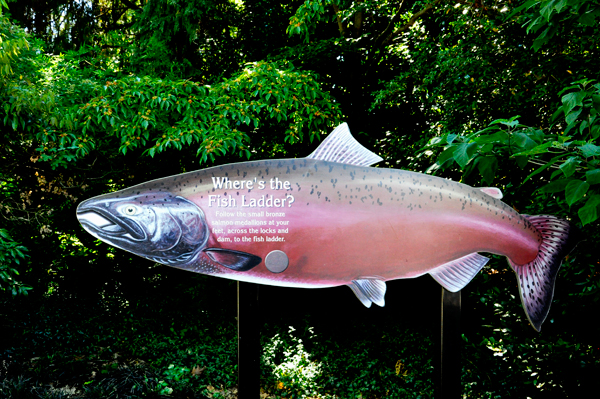
|
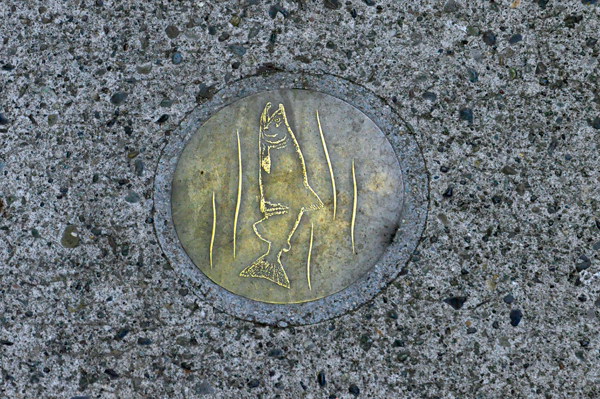
|
Below: Lee Duquette stopped to look at
a miniature garden before entering the Visitor Center. |
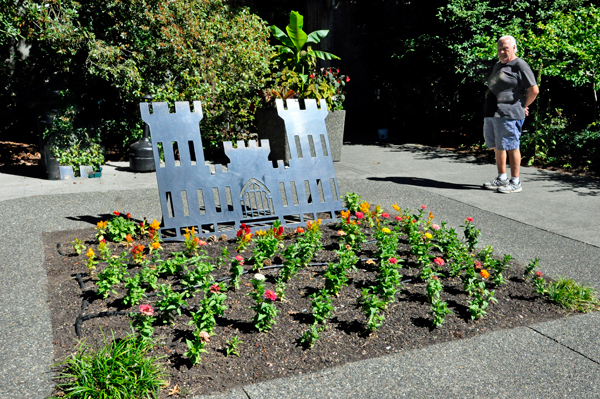
|
|
Vessels passing from the freshwater Lakes Washington and Union to Puget Sound enter the lock chamber through the open upper gates (A in the accompanying diagram). The lower gates (B) and the draining valve (D) are closed. The vessel is assisted by the lockwall attendants who assure it is tied down and ready for the chamber to be drained.
Next, the upper gates (A) and the filling valve (C) are closed and the draining valve (D) is opened allowing water to drain via gravity out to Puget Sound.
When the water pressure is equal on both sides of the gate, the lower gates (B) are opened, allowing the vessels to leave the lock chamber. |
Below: The above process is reversed
for upstream locking. |
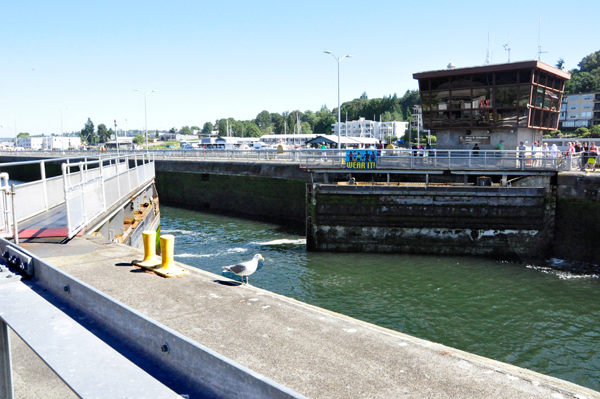
|
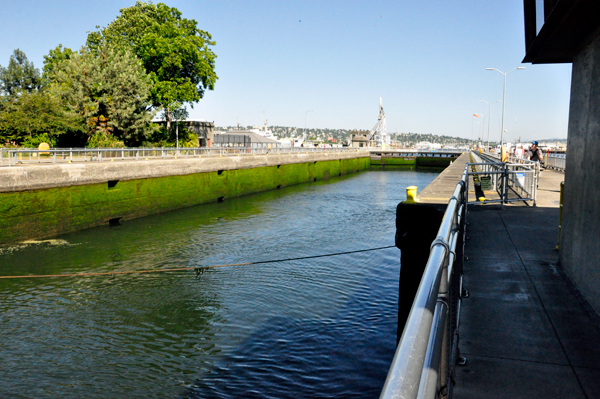
|
Below: One small boat is in the lock and the water is being raised. |
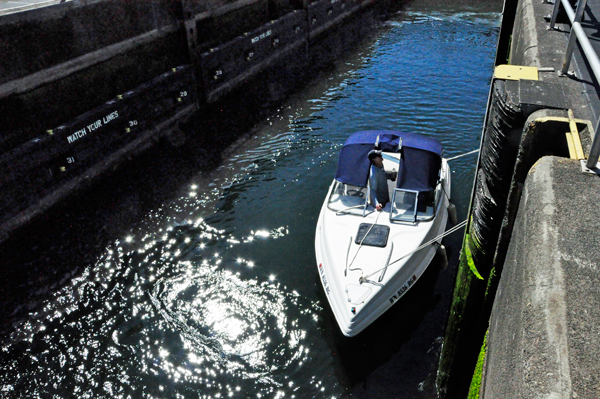
|
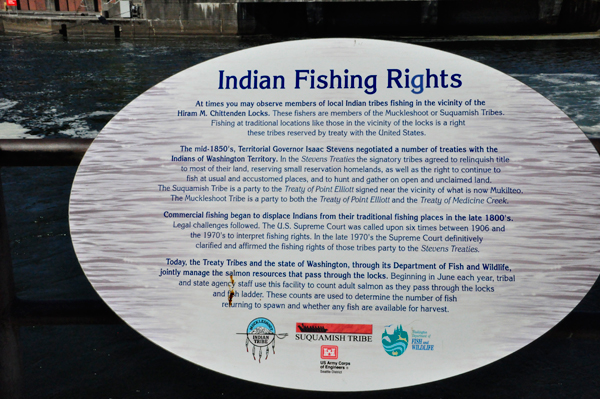
|
Below: The two RV Gypsies and Ilse Blahak
walked over the bridge and learned more about the fish and how they
travel through this area. |
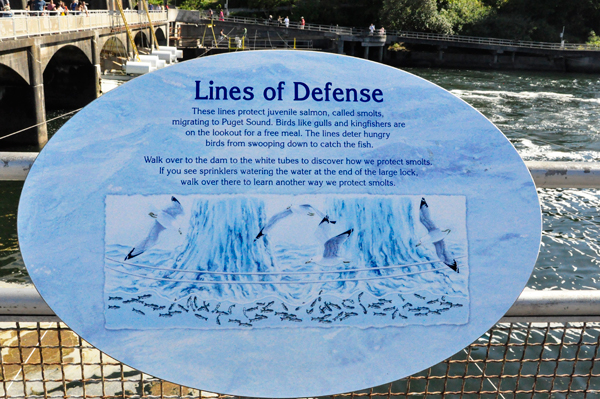
|
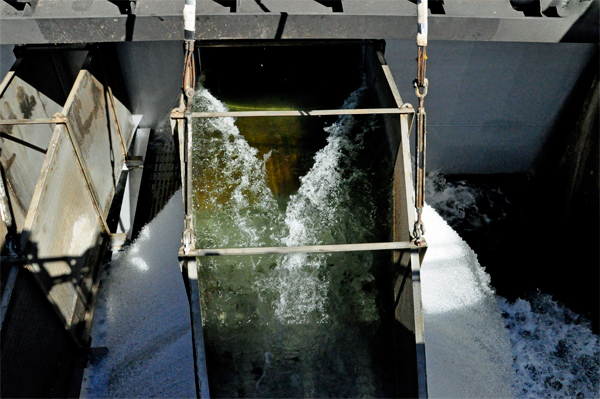
|
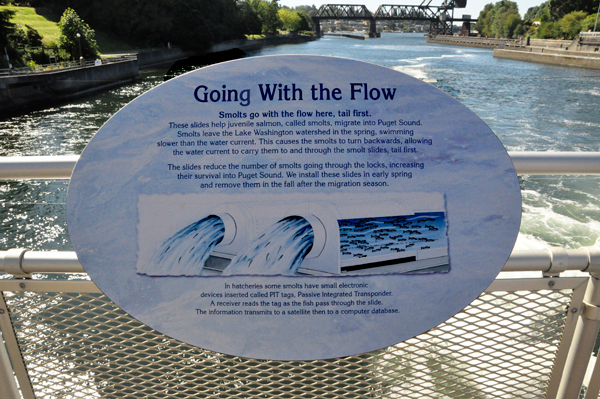
|
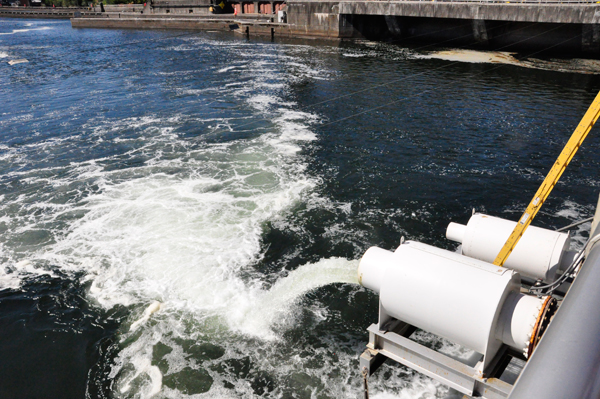
|
 South of the small lock is a spillway dam with tainter gates used to regulate the freshwater levels of the ship canal and lakes. The gates on the dam release or store water to maintain the lake within a 2 foot range of 20 to 22 feet above sea level. Maintaining this lake level is necessary for floating bridges, mooring facilities, and vessel clearances under bridges. South of the small lock is a spillway dam with tainter gates used to regulate the freshwater levels of the ship canal and lakes. The gates on the dam release or store water to maintain the lake within a 2 foot range of 20 to 22 feet above sea level. Maintaining this lake level is necessary for floating bridges, mooring facilities, and vessel clearances under bridges.
"Smolt flumes" in the spillway help young salmon to pass safely downstream. Higher water levels are maintained in the summer to accommodate recreation as well as to allow the lakes to act as a water storage basin in anticipation of drought conditions.
|
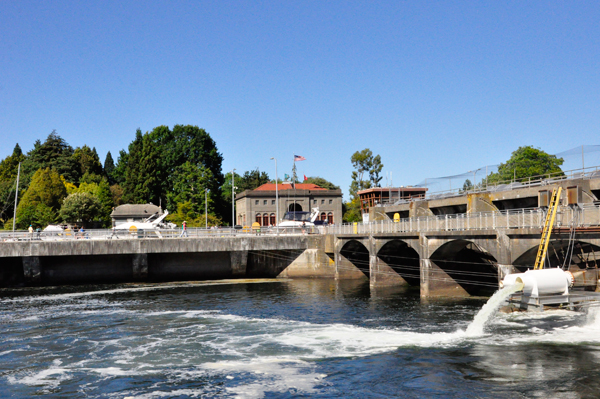
|
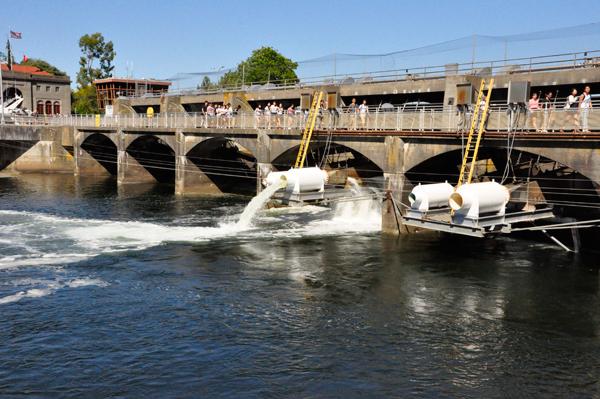
|
Below: Karen Duquette noticed some seals
in the water and photographed them. |
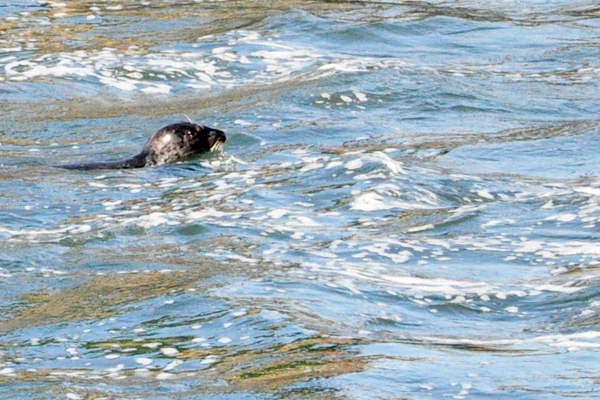
|
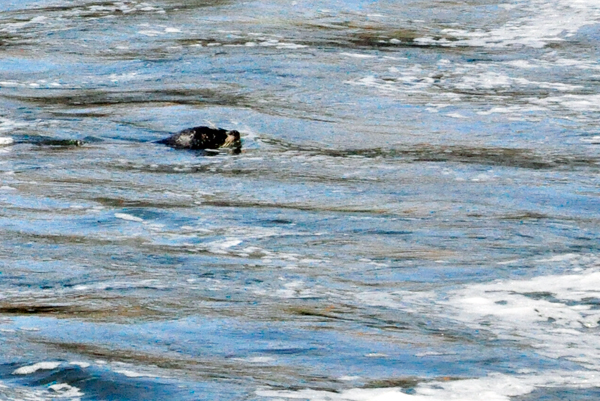
|
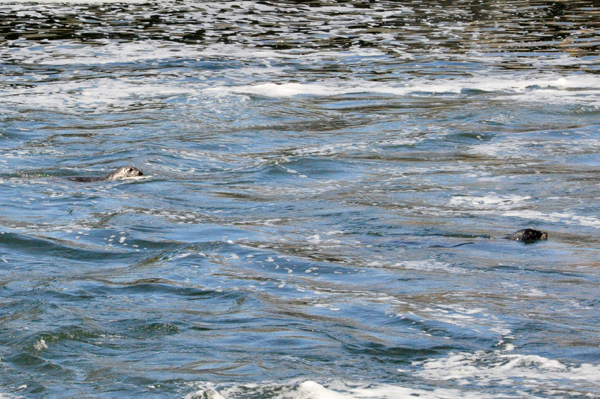
|
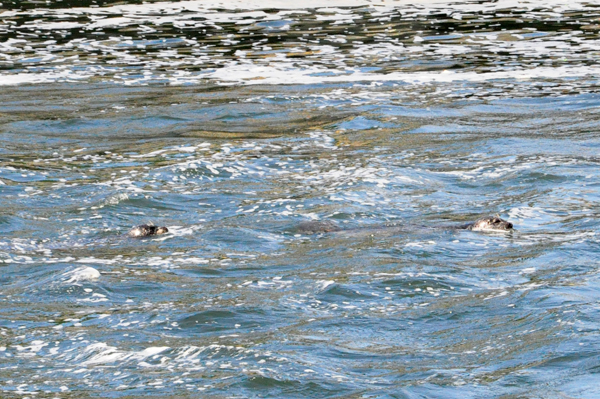
|
Below: There were also some fish swimming
around in the murky waters. |
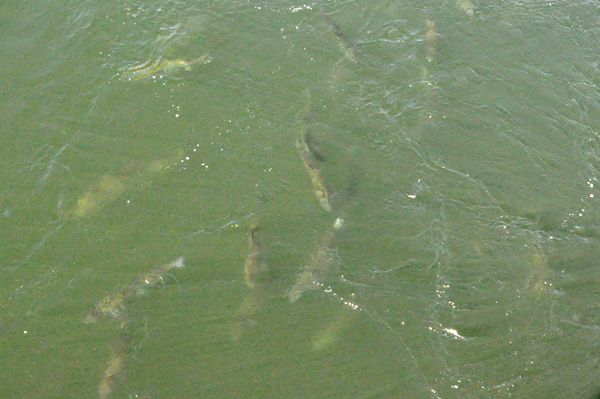
|
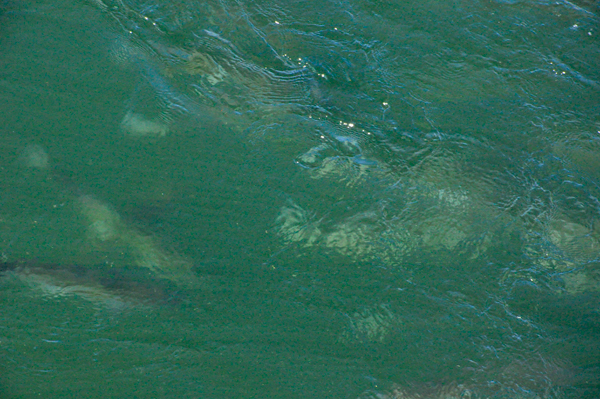
|
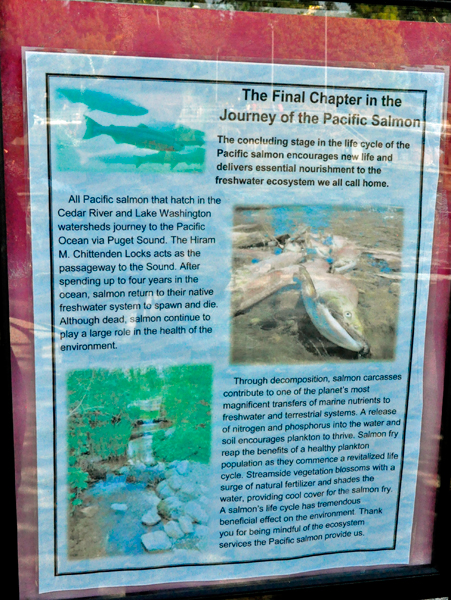
|
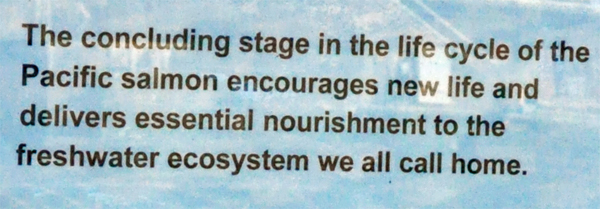 |
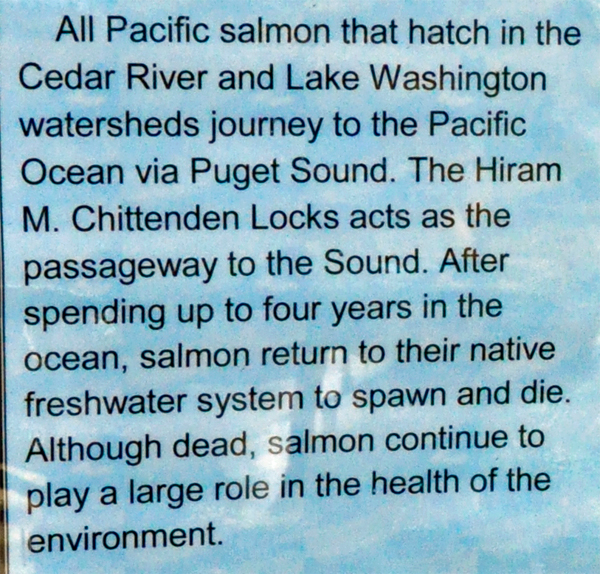
|
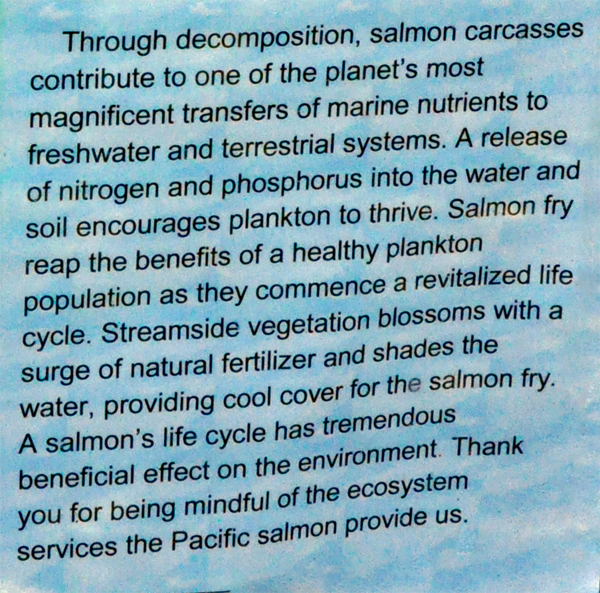
|
Below: Lee and Karen Duquette entered the
fish ladder and watched the salmon through windows as they progressed
along their route. |
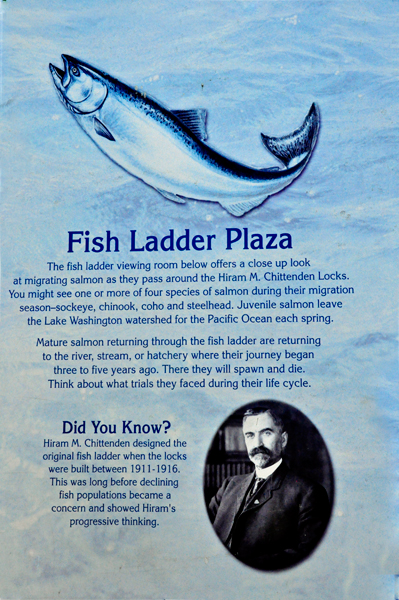
|
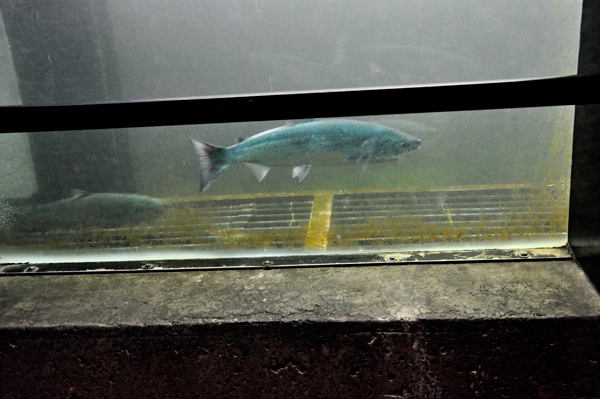
|
The fish ladder at the Chittenden locks is unusual. Normally, fish ladders are located entirely within fresh water. Pacific salmon are anadromous; they hatch in lakes, rivers, and streams, or nowadays fish hatcheries, then migrate to sea, and only at the end of their life return to fresh water to spawn.
 When the Corps of Engineers first built the locks and dam, they changed the natural drainage route of Lake Washington. The locks and dam blocked all salmon runs out of the Cedar River watershed. To correct this problem, the Corps built a fish ladder as the locks were constructed to allow salmon to pass around the locks and dam. The ladder was designed to use attraction water: fresh water flowing swiftly out the bottom of the fish ladder, in the direction opposite which anadromous fish migrate at the end of their lives. However, the attraction water from this first ladder was not effective. Instead, most salmon used the locks. This made them an easy target for predators; also, many were injured by hitting the walls and gates of the locks, or by hitting boat propellers. The Corps rebuilt the fish ladder in 1976 by increasing the flow of attraction water and adding more weirs. The old fish ladder had only 10 "steps"; the new one has 21. A diffuser well mixes salt water gradually into the last 10 weirs. As a part of the rebuilding, the Corps also added an underground chamber with a viewing gallery. When the Corps of Engineers first built the locks and dam, they changed the natural drainage route of Lake Washington. The locks and dam blocked all salmon runs out of the Cedar River watershed. To correct this problem, the Corps built a fish ladder as the locks were constructed to allow salmon to pass around the locks and dam. The ladder was designed to use attraction water: fresh water flowing swiftly out the bottom of the fish ladder, in the direction opposite which anadromous fish migrate at the end of their lives. However, the attraction water from this first ladder was not effective. Instead, most salmon used the locks. This made them an easy target for predators; also, many were injured by hitting the walls and gates of the locks, or by hitting boat propellers. The Corps rebuilt the fish ladder in 1976 by increasing the flow of attraction water and adding more weirs. The old fish ladder had only 10 "steps"; the new one has 21. A diffuser well mixes salt water gradually into the last 10 weirs. As a part of the rebuilding, the Corps also added an underground chamber with a viewing gallery.
|
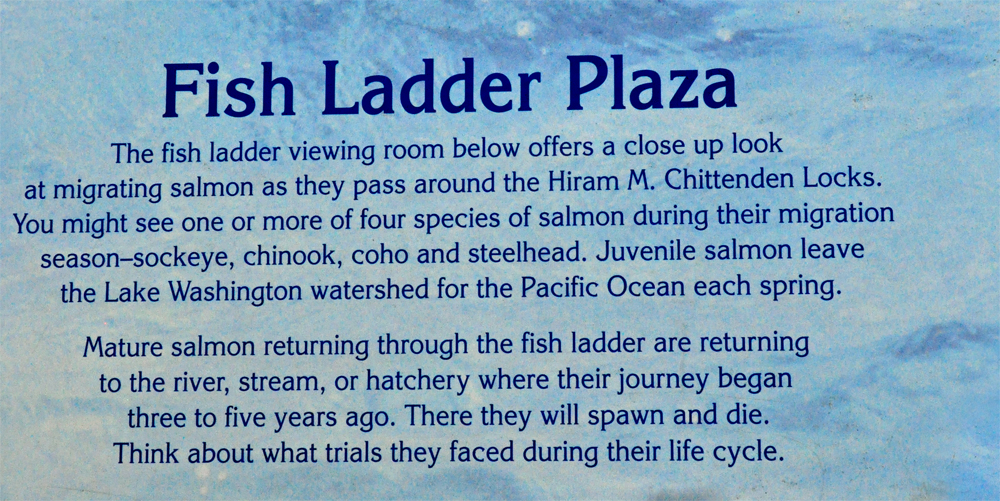
|
The fish approaching the ladder smell the attraction water, recognizing the scent of Lake Washington and its tributaries. They enter the ladder, and either jump over each of the 21 weirs or swim though tunnel-like openings. They exit the ladder into the fresh water of Salmon Bay. They continue following the waterway to the lake, river, or stream where they were born. Once there, the females lay eggs, which the males fertilize. Most salmon die shortly after spawning.
The offspring remain in the fresh water until they are ready to migrate to the ocean as smolts. In a few years, the surviving adults return, climb the fish ladder, and reach their spawning ground to continue the life cycle. Of the millions of young fish born, only a relative few survive to adulthood. Causes of death include natural predators, commercial and sport fishing, disease, low stream flows, poor water quality, flooding, and concentrated developments along streams and lakes. |
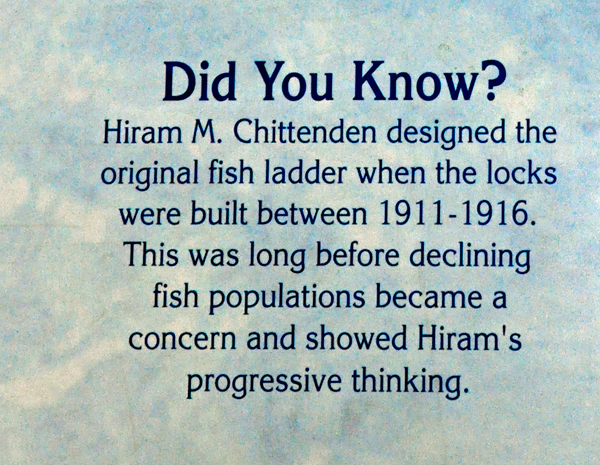
|
Below: At the end of the bridge, some shiny artwork sparkled in the sunlight. |
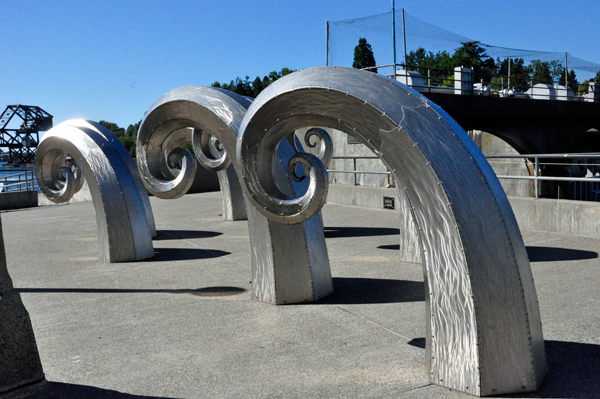
|
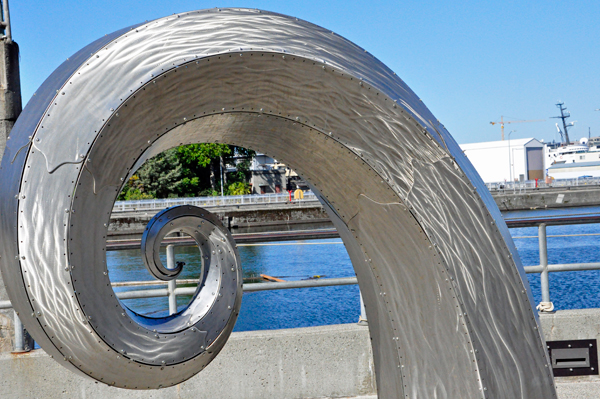
|
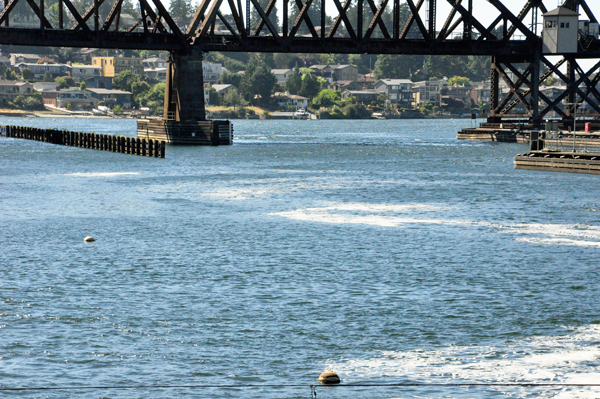
|
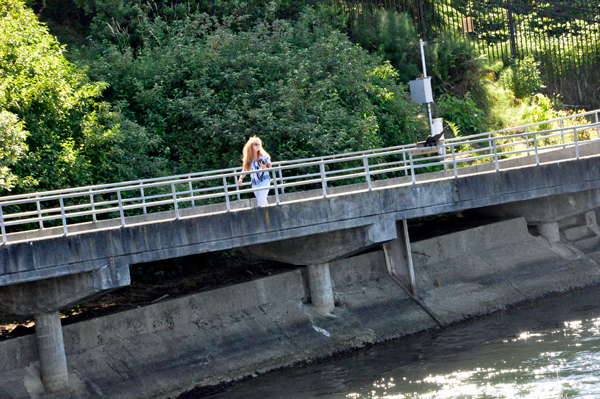
|
Below: Crossing back to the locks, Lee
and Karen Duquette watched big and small boats getting settled in, and
listened to the employees explain what was happening. The locks can
elevate a 760 by 80-foot wide vessels, 26 feet from the level of Pugent
Sound to the level of Salom Bay in 10-15 minutes. It accommodates many
vessels, from kayaks to large ocean-going ships. |
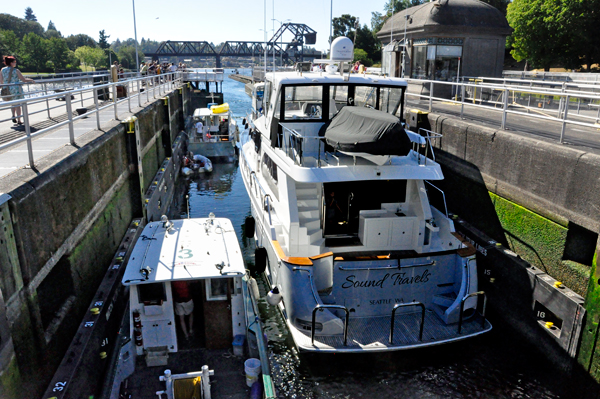
|
On the way out, Karen Duquette photographed
flowers she had NOT seen before. Unfortunately, there were not any labels
to tell her what these were called. If you know what these flowers are,
please e-mail the two RV Gypsies through the button at the bottom of
this page (mention what page you are referring to). Thank you. |
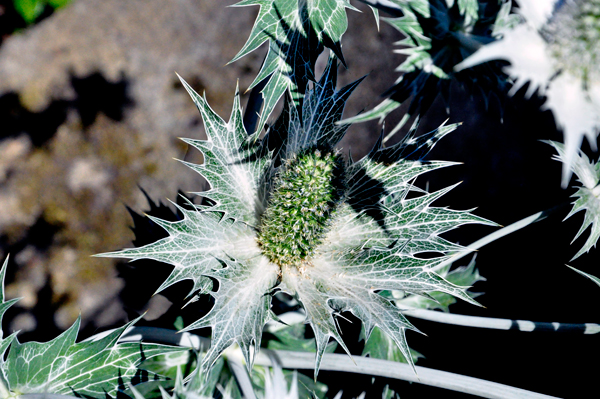
|
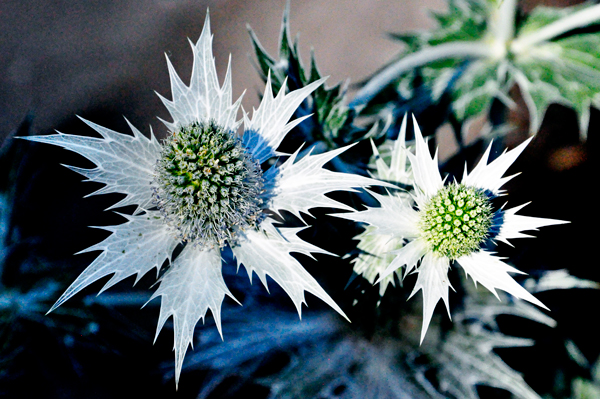
|
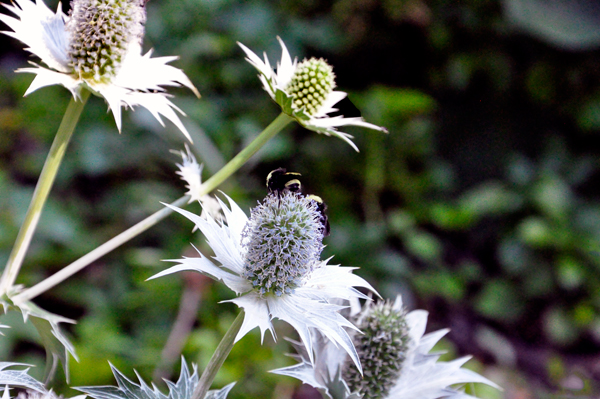
|
The above information is from Wikipedia, the free encyclopedia online, and from a brochure acquired at the Visitor Center at the Locks. |
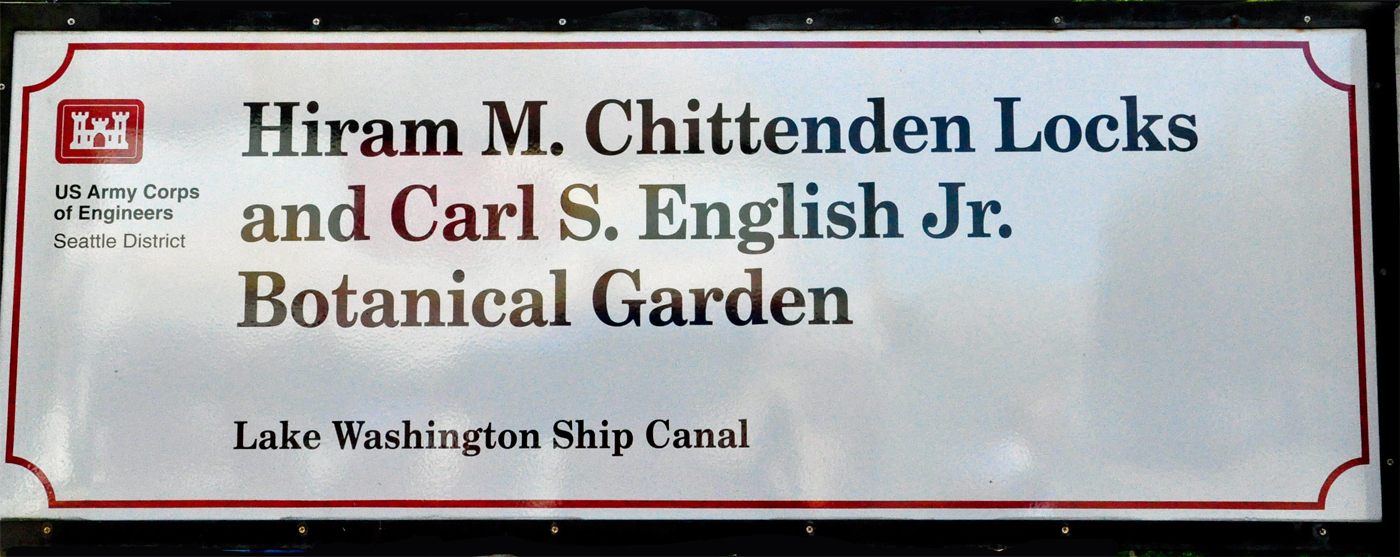
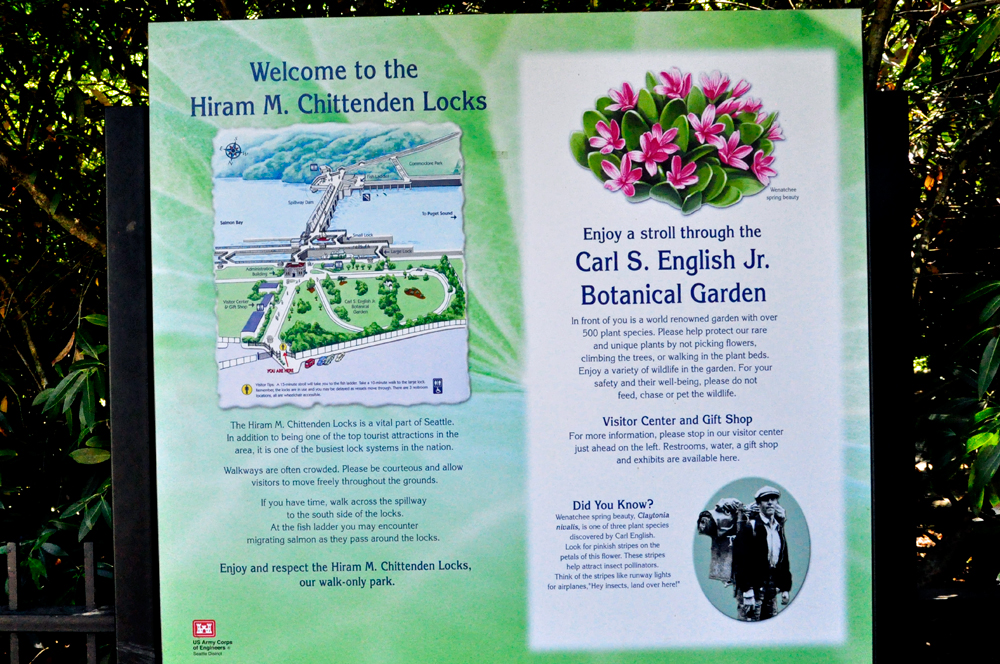
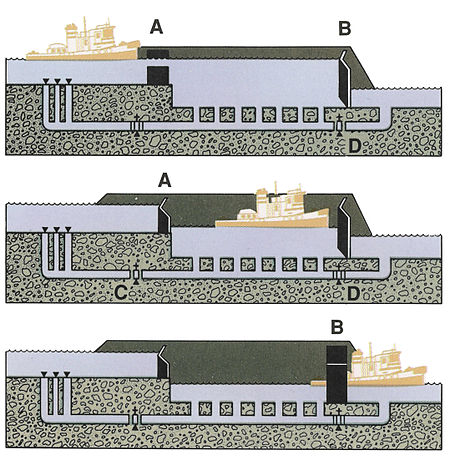

 The Hiram M. Chittenden Locks, or Ballard Locks, is a complex of locks at the west end of Salmon Bay in Seattle, Washington's Lake Washington Ship Canal, between the neighborhoods of Ballard to the north and Magnolia to the south. The Ballard Locks carry more boat traffic than any other lock in the US. The construction of the locks profoundly reshaped the topography of Seattle and the surrounding area, lowering the water level of Lake Washington and Lake Union by 8 feet, adding miles of new waterfront land, reversing the flow of rivers, and leaving piers in the eastern half of Salmon Bay high and dry.
The Hiram M. Chittenden Locks, or Ballard Locks, is a complex of locks at the west end of Salmon Bay in Seattle, Washington's Lake Washington Ship Canal, between the neighborhoods of Ballard to the north and Magnolia to the south. The Ballard Locks carry more boat traffic than any other lock in the US. The construction of the locks profoundly reshaped the topography of Seattle and the surrounding area, lowering the water level of Lake Washington and Lake Union by 8 feet, adding miles of new waterfront land, reversing the flow of rivers, and leaving piers in the eastern half of Salmon Bay high and dry.




























































